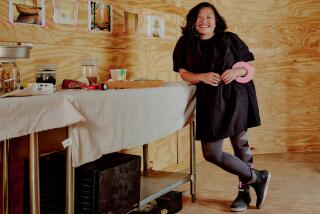One City, Two Worlds
- Share via
PHNOM PENH, Cambodia — This city never was one of those places I had dreamed of visiting. Images of killing fields and poverty always lingered, and the fabled temples of Angkor, the country’s main draw, were 190 miles away.
But my American friend Victoria was living there, and I was going to Angkor anyway, so I took the plunge. I’m glad I did.
What I found in Cambodia’s capital was a study in contrasts. Shoppers browse for lush silks near former houses of torture. Elegant hotels abut squalor. Lively nightspots operate near old war zones. Phnom Penh turned out to be the most interesting--and moving--destination on my Southeast Asia trip earlier this year.
The 15-minute drive from tiny Pochentong Airport didn’t bode well. I paid the official taxi fare into town ($7), and my driver needled me as we bumped along past millions of motor scooters on prodigiously potholed streets: “Your hotel full. I take you different hotel?” (“No.”) “You want lady?” (“No.”) “You need driver?” (“Uhhh, no. Thank you.”)
When Victoria called to say she would pick me up with her own driver, I was grateful. But she showed up carrying a bicycle helmet, and I gulped as I realized she rode around town on the back of a motor scooter. “Come on!” she said enthusiastically. “Let’s find you a moto too!”
Her attitude typified the optimism that has gained tenuous hold here since the death of former dictator Pol Pot in 1998 and the subsequent demise of his Khmer Rouge regime. After six centuries of invasion and occupation by foreigners, not to mention the corruption and unspeakable genocide of the 1970s, Cambodia seems to have turned a corner. Citizens have begun to travel again, Victoria said, and political freedom seems to be gaining.
But make no mistake: Cambodia is still struggling. The average monthly income is $50, and most people are subsistence farmers.
The roads are evidence of decades of neglect. Phnom Penh’s streets are pocked with rivulets that are yards long and infinitely deep. You often see vehicles veering into the path of oncoming traffic, particularly when turning left or crossing wooden bridges with slats missing. From above, traffic must look like DNA replicating.
I needn’t have worried about motos, though. In the hands of capable drivers, or “moto dops,” they can be fun. (Mine was called “Smiley,” and by charging $1 per hour, he certainly was.) Scooters outnumber other vehicles 10 to 1. They usually carry individuals or couples, but don’t be surprised to see an entire family aboard, the mother sitting sidesaddle with an open pot of soup in her lap.
We started out at the National Museum, a tall-roofed, deep red terra-cotta structure filled with treasures from the Khmer temples of Angkor to the northwest. Many of these splendid sculpted Buddhas, Sivas and apsaras (female celestial dancers) are originals from the 9th through 14th centuries, stored here to prevent looting; the ones at Angkor are replicas.
Amid these masterpieces, Victoria laid down Cambodian history: Around the 9th century, Angkor-based rulers of the Khmers (an ethnic group dating to about the 3rd century) collected taxes from locals and from conquered peoples in what are now Vietnam, Laos, Thailand and Myanmar. These funds went to build elaborate temple-cities throughout the region, based first on Hinduism and later Buddhism, the most shining examples of which were in the capital. After the Thais sacked Angkor in 1431, the capital moved to more defensible Phnom Penh and the empire never regained its former glory. Weak kings went on to rule under Thai-, Vietnamese- or French-controlled regimes before the region fell under Japanese control during World War II.
The greatest devastation, however, was home-grown, at the hands of the Khmer Rouge under Pol Pot. That guerrilla regime ruled from 1975 to 1979, when Cambodia slipped into a miasma of genocide, militarism, illiteracy and economic stagnation. Estimates on the deaths vary, but one research center says the Khmer Rouge killed 1.7 million of 7.9 million people in Cambodia at the time.
In tribute to those who suffered, our next stop was the Choeung Ek Genocidal Center, the local killing fields. To get there, we rode about nine miles out of town through 90-degree heat on mostly dirt roads.
The approach to Choeung Ek is bucolic. Oxen graze and children skip over flat plains. Inside, though, thick grass fills dozens of deep pits, former mass graves from which 8,985 bodies were disinterred in 1980. About 8,000 human skulls lie in a tall stupa in the center, with femurs and other bones stacked on shelf after shelf.
These victims were the wealthy, intellectuals or any man, woman or child suspected of opposing Pol Pot’s vision for a peasant-dominated agrarian society. Victoria explained that as economic conditions declined in the late ‘70s, bullets were in short supply and “they just brought people out here and beat them.” Plaques on trees bear out the deaths; one shows where children were beaten.
We returned to the city, where business as usual stood in sharp contrast to Choeung Ek. In the streets and markets, the horrors of the past weren’t nearly as obvious; modern society, by comparison, seemed focused on practical concerns, such as making a buck.
Phnom Penh is full of places hawking inexpensive local crafts, silks and clothing. The music and video-game CDs may be bootlegged, but many American clothing brands like Gap and Old Navy are authentic: made in Cambodia, with seconds and often firsts available at fractions of their stateside prices. I bargained hard and bought a pair of Old Navy painter pants for $3.50.
We walked through the Russian Market, stalls in a souk-like building on the edge of town. Merchants near the south entrance sold kramas (checked scarves of cotton or cotton-silk blend that seem to be the national dress) and shimmering silks for up to $25, depending on their intricacy. We also stopped at the New Market, a hulking Art Deco ziggurat near the center of town.
As the sun set, we headed out across the Tonle Sap River to miles of restaurants and nightclubs.
We ended up at Hang Neak, a covered, open-sided space that felt like an airplane hangar and was as long as a football field. Locals at large, round tables ate their fill of Cambodian, Thai, Vietnamese and Chinese specialties while watching a cavalcade of entertainment on a stage. Singers warbled “Tonight I Celebrate My Love” in Khmer, and traditional dancers flexed their wrists and glided around in golden headdresses. Everyone seemed to enjoy the flamenco numbers and the drag show from Thailand.
We ordered tiny Vietnamese spring rolls, cut in half and accompanied by a sweet chile sauce. I loved the flank steak grilled and sliced thin, with sides of peppery soy sauce, cabbage, cucumbers, string beans and fresh basil. The squid with garlic sauce was perhaps the best I’ve had--unbelievably tender, brought from sea to table in just a few hours.
“Beer girls” served the crowd in slinky dresses with sashes advertising Angkor or Tiger beers, Hennessy cognac, Cutty Sark and my favorite, “House Red, California.” The evening’s cost: $7 per person.
Victoria explained that most Cambodians do not stay out much past 8 p.m. But as nonnatives, we headed out for drinks at the Foreign Correspondents Club, a restaurant and bar in a four-story colonial building overlooking the manicured river promenade.
The FCC is a great place to hang out, although it doesn’t carry the prestige its name may imply. The club, opened in 1993, is neither specifically for journalists nor foreigners (although with beer starting at $1.20, it’s too expensive for most Cambodians).
Cambodia also has the sort of late-night bar that polite people don’t talk about. That Cambodia has accepted Thailand’s crown as Southeast Asia’s prostitution queen was all too clear in one quick visit to Sharky’s bar.
Victoria had gone home, and I arrived at Sharky’s to find a Khmer woman who practically attached herself to me. As I circled the bar, three more joined. The place was filled with clusters: one Western man surrounded by several Khmer women. Too disturbed by the scene, I couldn’t stay more than two minutes.
The next morning I did a quick pass by the impressive Palace of King Norodom Sihanouk (the public is allowed only in limited areas) en route to the Tuol Sleng Museum, formerly Phnom Penh’s main house of torture.
Given that the educated were primary targets, it is eerily appropriate that this building had been a high school. Elaborate lists of rules are posted where chalkboards might have been, including admonitions not to cry while being lashed. Classrooms are subdivided into cells with enough room to curl into a fetal position but not stretch out on the floor.
Galleries in the rear buildings are filled with wrenching photos of Cambodians awaiting some terrible fate, and a board tallies the losses: humans killed or “disappeared” (3.3 million), homes (635,500), schools (5,857), hospitals (796), houses of worship (2,100) and cattle (1.5 million).
On the way back to my hotel, though, I spotted a group of boys, perhaps 7 or 8 years old, at the road’s edge, trying to negotiate the street’s deep crevices on roller skates. Their motions were sloppy, and they occasionally stumbled. But they were on their way.
(BEGIN TEXT OF INFOBOX / INFOGRAPHIC)
GUIDEBOOK
Phnom Penh, Past and Present
Getting there: Connecting service from LAX to Phnom Penh is available on Thai Airways, Malaysia Airlines and China Southern Airlines. Restricted round-trip fares begin at $1,305.
Currency: U.S. cash is the preferred currency. (You most likely will receive change in Cambodian riels, so bring lots of small bills.) Credit cards and traveler’s checks are accepted only at high-end establishments.
Where to stay: Hotel Le Royal is an oasis of elegance and peace. Double rooms start at $290 per night; 92 Rukhak Vithei Daun Penh (off Monivong Boulevard), telephone 011-855-23-981-888, fax 011-855-23-981-168, Internet https://www.raffles-intl.com/raffles.htm, e-mail [email protected].
Low-end rooms are as cheap as $10 per night (although often dirty at that price). For $15, I settled into the Cathay Hotel, near downtown. My double room was spartan but clean and large, with air-conditioning and TV. Staff was helpful. 123-125 St. Ang Duong, tel. 011-855-23-722-471, fax 011-855-23-426-303.
A nice compromise is Sunway Hotel, with doubles starting at $75 per night; No. 1 St. 92, Sangkat Wat Phnom, tel. 011-855-23- 430-333, fax 011-855-23-430-339, Internet https://www.jaring.my/allson/cambo.htm, e-mail [email protected].
Where to eat: Hang Neak features Cambodian, Thai, Vietnamese and Chinese specialties for $3 to $5 each. It lists its address as “about 3 kilometers (1.9 miles) east of Chroy Changwa Bridge,” no telephone.
Dara Reang Sey is a comfortable, casual place overlooking downtown. Khmer and Chinese food starts at about $1.50 per dish. 45Eo St. 118, Corner St. 13, local tel. 428-181.
The Foreign Correspondents Club is comfortable in a British Raj sort of way, serving Western food at almost Western prices. 363 Sisowath Quay, tel. 724-014.
Advisory: The U.S. State Department has issued a warning about parts of Phnom Penh for April. See Travel Advisory on L22.
For more information: Royal Embassy of Cambodia, 4500 16th St. N.W., Washington, DC 20011; tel. (202) 726-7742, Internet https://www.embassy.org/cambodia/.
More to Read
Sign up for The Wild
We’ll help you find the best places to hike, bike and run, as well as the perfect silent spots for meditation and yoga.
You may occasionally receive promotional content from the Los Angeles Times.






